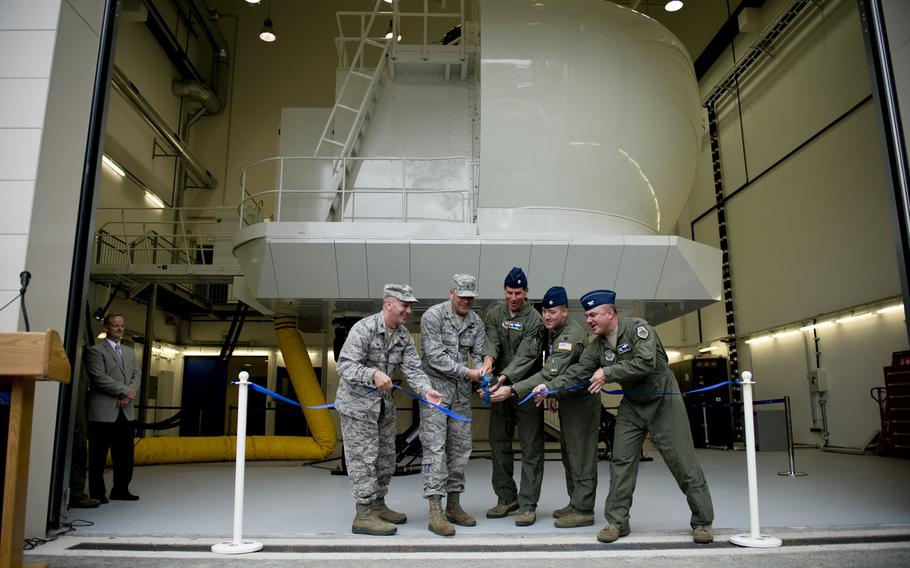
Brig. Gen. Jon T. Thomas, 86th Airlift Wing commander, second from left, and other 86th Airlift wing leaders cut a ribbon during the C-130J simulator opening ceremony at Ramstein Air Base, Germany, Monday, Aug. 24, 2015. Ramstein is the first U.S. Air Force base overseas to employ a C-130J simulator for its pilots and aircrews. (Michael Keller/Stars and Stripes)
RAMSTEIN AIR BASE, Germany — It looks like an alien spacecraft your kid might want to take for a spin.
But this is no amusement park ride.
Ramstein is the first U.S. Air Force base overseas to get a C-130J Maintenance and Aircrew Training System — a fancy name for a flight simulator. It will be used to train aircrews that fly the C-130J Super Hercules from Ramstein and the maintainers who keep them ready to fly.
The 86th Airlift Wing hosted a ribbon-cutting ceremony Monday for the $25 million simulator and the new building that houses it, an $8 million military construction project.
The windowless simulator was open for visitors to take a peek inside, where Maj. Devon Cummings, an operations officer with the 86th Operational Support Squadron, practiced a “landing” on Ramstein’s runway. The physical features whizzing by on the video screen looked exactly as the pilot would see them approaching for landing, from the buildings along the airfield to the farm fields surrounding the base.
“Not bad. You’re qualified,” joked C-130J pilot Capt. Fred Backhus, who was leading Cummings through the drill.
Backhus said the simulator comes with a visual database system programmed to display most airfields to which the crews fly. “We just program it in: ‘We want to go here today.’ Boom, it’s there,” he said.
The mechanical legs that support the simulator can move, replicating aircraft turns.
Can it dish out turbulence?
“I don’t know,” said Master Sgt. Mike Ferry, a loadmaster with the 37th Airlift Squadron. “We’ve never done it.”
Despite the millions of dollars that went into it, Air Force officials say the entire project likely will pay for itself in about seven years. Pilots can do initial and refresher training on the simulator, including required annual training that previously had to be performed at two bases in the States with simulators.
With a simulator in Germany, Ramstein crews will be able do more training on the ground and less in the air, which will cut fuel costs and aircraft wear and tear.
“We can do pretty much anything, training-wise, we need to,” Backhus said. “It’s about as realistic as it can get without being in the actual airplane.”
The simulator allows training for emergency and other situations that would be too dangerous to replicate in the air, such as flying after an engine goes out or when an airdrop goes wrong.
But the simulator is not an absolute substitute for time in the cockpit when it comes to certain maneuvers, such as landing on short airfields, Backhus said. Only 50 percent of these so-called assault landings can be completed in a simulator.
Ramstein’s C-130J crews often see these shorter runways when flying to airfields in Africa, he said.
The crews fly “everywhere,” logging many miles all over the European theater, including eastern Europe, and in Africa, said Ferry.
Loadmasters have a seat in the simulator to help pilots work through practice emergency procedures and complicated airdrops in specific drop zones, Ferry said.
A small staff of contractors will lead instruction in the simulator and will operate and maintain the device, officials said.